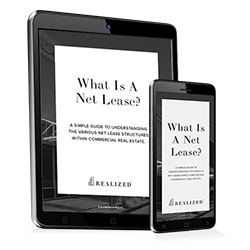The Realized Team’s Picks
Triple Net Leases and Estate Planning: What Investors Should Consider

As an investor, planning for the future requires an in-depth understanding of what your current assets can do to ensure stability, minimize tax liability, and preserve wealth. Those who are planning to enter triple net (NNN) leases must also take into account how such an investment can impact their long-term estate plans.
Healthcare UPREITs: Investing in Medical and Senior Housing Facilities

In an economic landscape characterized by an aging population and increasing healthcare demands, investing in healthcare-focused UPREITs (Umbrella Partnership Real Estate Investment Trusts) presents a strategic opportunity for savvy investors. This investment vehicle merges the stability of real estate with the growth potential of the healthcare sector, focusing on medical and senior housing facilities.
Fractional Ownership Structures in NNN Lease Properties

Direct and sole ownership is one of the most common ways to invest in a triple net (NNN) lease asset, but certain situations or financial goals make fractional ownership a more appealing and practical option. Fractional ownership is simply a model where multiple people share the ownership of an asset. So, how does it work? What are the different types of fractional ownership? Realized 1031 shares the answers in this insightful guide.
Triple Net Lease Exit Strategies: What Options Are Available to Owners

Investing in a triple net lease (NNN) asset offers long-term and stable cash flow. However, there may come a time when you want to exit for whatever reason. What are the strategies available that can help you maximize your returns? Let’s look at some possible avenues to help you prepare ahead. Keep reading to learn more about triple net lease exit strategies.
How Triple Net Leases Compare to REIT Investments

For the modern investor, two popular options often emerge when seeking opportunities that promise passive involvement and long-term income: triple net leases (or NNN leases) and real estate investment trusts (REITs). The two options offer similar benefits, but they have differing structures that result in varying levels of risk, involvement, and stability.
Creditworthiness of Tenants and Why It Matters in NNN Leases

Two factors contribute the most to the success of a triple net (NNN) lease: the property and the tenant. For the latter, you must choose a tenant that can handle the financial responsibility of paying for property taxes, insurance premiums, and maintenance costs. A creditworthy tenant is naturally the ideal occupant, helping reduce the risk of default and ensuring the long-term stability of the lease. In this article, Realized 1031 shares the specifics of why creditworthiness is a critical consideration in an NNN investment. Let’s take a closer look!
How Interest Rate Changes Impact Triple Net Lease Investments

Before investing in triple net (NNN) leases and enjoying benefits like steady cash flow, it’s important for investors to take into consideration how broader market conditions affect these assets.
The History and Evolution of Triple Net Leases in Commercial Real Estate

Triple net (NNN) leases are a popular investment choice today, with many leveraging these assets as cornerstones of their portfolios. Before they became the contemporary strategy for long-term investment that they’re now known for, however, NNN leases had to undergo an evolution that shaped them into the tools they are.
Combining DSTs and Triple Net Leases: Strategies for Tax Deferral

A triple-net (NNN) lease investment offers numerous benefits, including hands-off involvement and steady income, making it a popular choice for many modern investors. The most direct way to access this investment is through direct ownership; however, did you know that other methods offer additional benefits?
Triple Net Lease vs. Ground Lease: Pros and Cons for Investors

Real estate investors often leverage structured lease agreements to ensure steady income and long-term investment success. While many lease variations exist, there are two that share similarities: the triple net lease and the ground lease. Both provide benefits such as predictable cash flow and hands-off involvement, but each one has its own pros and cons that can complicate the selection process.


